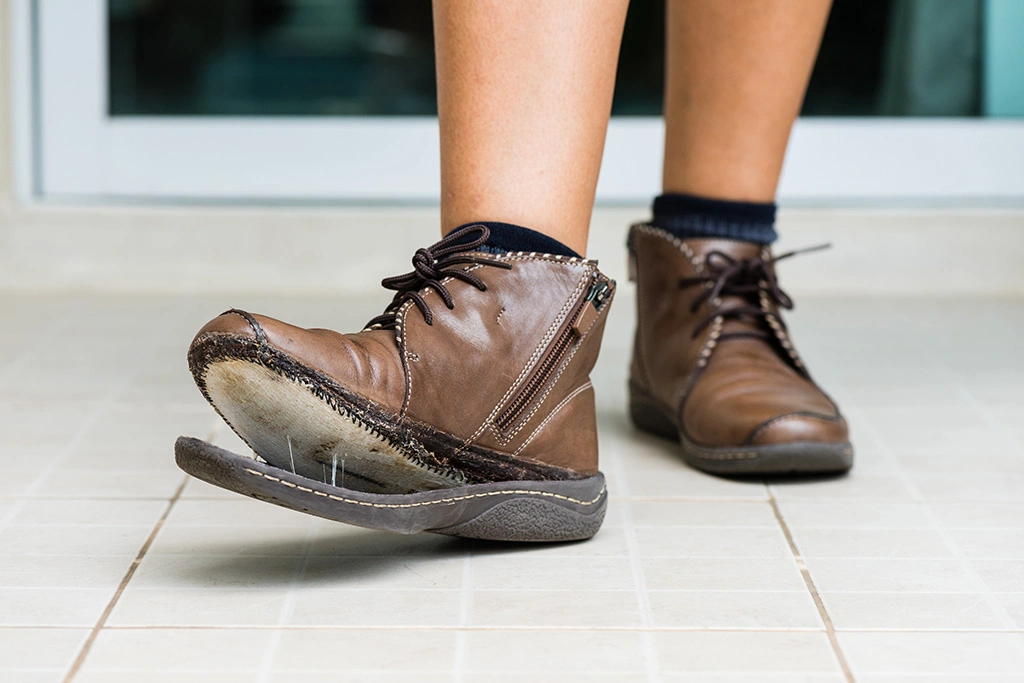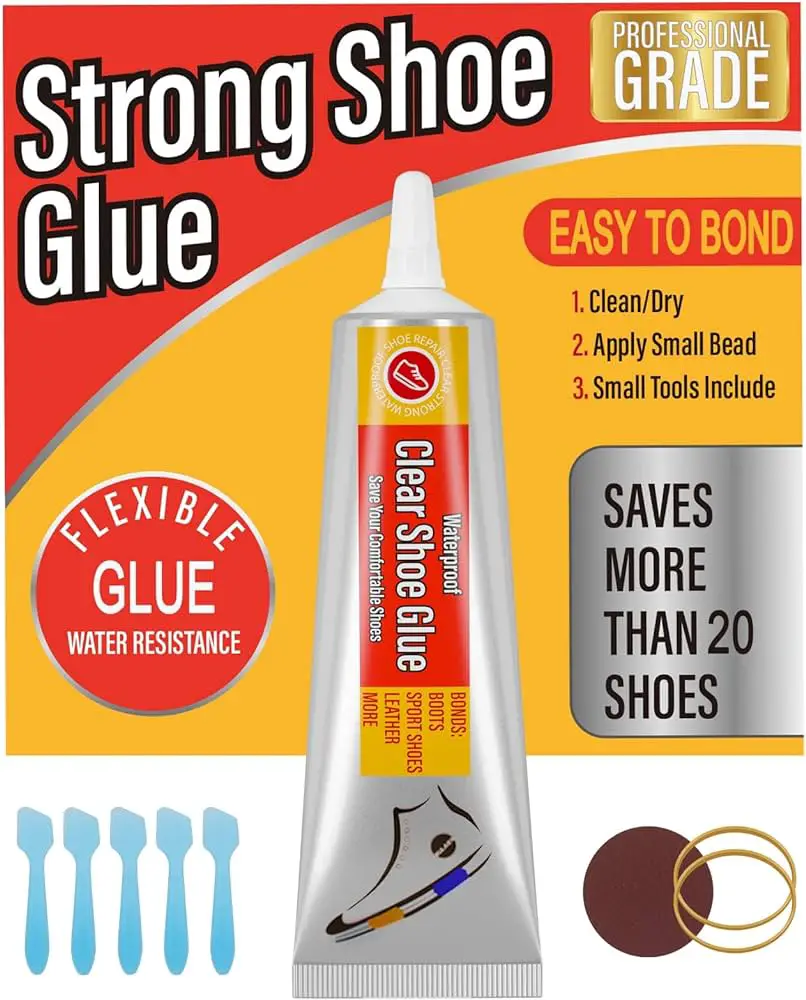Looking for a good glue for shoes? Look no further than Shoe Goo.
This versatile adhesive is perfect for all types of shoe repairs and is specially designed to withstand the wear and tear of everyday use. Shoe Goo is a popular choice among both professionals and DIY enthusiasts for its strong bond and durability.
Whether you need to fix a sole, mend a tear, or waterproof your shoes, Shoe Goo has got you covered. Keep your favorite footwear looking great and lasting longer with this reliable shoe glue.
Choosing The Right Glue
Vivacious Glue: Choose Your Adhesive Wisely
When repairing shoes, selecting the correct glue is imperative for a strong and durable bond. Let’s explore how to choose the right adhesive for your needs.
Consider The Type Of Shoe
Every shoe material requires specific glue for optimal adhesion. Some common shoe materials and their suitable glues are:
| Shoe Material | Recommended Glue |
|---|---|
| Leather | Shoe adhesive or leather cement |
| Rubber | Neoprene-based or urethane rubber adhesive |
| Fabric | Fabric glue or hot glue |
Understanding Different Glue Formulas
Various glue formulas cater to different shoe repair needs. Some common glue types and their applications include:
- Epoxy glue: Ideal for heavy-duty repairs
- Cyanoacrylate (super glue): Perfect for quick fixes but not suitable for all materials
- Shoe adhesive: Specifically designed for repairing footwear
Choosing the right glue based on your shoe material and repair requirements ensures a lasting and effective bond. Take time to evaluate your needs before making a selection.

Credit: www.hongteckhin.com.sg
Preparing The Shoe Surface
Preparing the shoe surface is crucial for ensuring a strong bond when using good glue for shoes. This step involves cleaning the surface and removing any old adhesive.
Cleaning The Surface
- Use a mild detergent and water to clean the shoe surface.
- Scrub gently with a soft-bristled brush to remove dirt and grime.
- Rinse the shoe thoroughly and allow it to dry completely before applying new adhesive.
Removing Old Adhesive
- Apply a solvent specifically designed for removing adhesive.
- Gently scrape off the old adhesive using a plastic scraper.
- Wipe the area clean with a damp cloth to ensure no residue remains.
Applying The Glue
When applying glue to your shoes, it’s crucial to do it correctly to ensure a strong and durable bond. A well-executed application process will make a significant difference in the longevity of your repaired shoes.
Using The Right Amount
Applying the right amount of shoe glue is crucial for a successful repair. Avoid using too much glue, as it can create a messy application and lead to uneven bonding. On the other hand, using too little glue may result in an incomplete bond.
Ensuring Proper Bonding
To ensure proper bonding, follow these steps:
- Clean the shoe surface thoroughly to remove any dirt, dust, or debris that could interfere with the bonding process.
- Apply the glue evenly and carefully to the areas needing repair, ensuring full coverage for a secure bond.
- Press the glued surfaces firmly together and hold them in place for the recommended drying time, as per the glue manufacturer’s instructions.
- Avoid putting pressure on the repaired area until the glue has fully cured to avoid compromising the bond.

Credit: www.wikihow.com
Allowing For Proper Drying And Curing
When it comes to repairing your favorite pair of shoes, having a good glue that allows for proper drying and curing is essential. Understanding the drying times and the importance of curing is crucial for a successful shoe repair. In this article, we will delve into the details, ensuring that you have all the necessary information to choose the right glue for your shoe repair needs.
Understanding Drying Times
Drying times can vary depending on the type of glue you are using. It’s essential to have a good understanding of the drying times to ensure you give your shoes enough time to set properly. Using a glue that dries quickly may seem convenient, but it can lead to a weaker bond and a shorter lifespan for your repair.
On the other hand, using a glue that takes too long to dry can be equally problematic. Waiting for hours or even days for the glue to dry can be frustrating, especially if you need to wear your shoes soon. Additionally, excessive drying time can increase the risk of the repair not sticking properly and coming undone.
Understanding the drying times of different adhesives can help you make the right choice for your shoe repair needs. Certain glues dry within minutes, while others may require a few hours. Always refer to the manufacturer’s instructions for the recommended drying time and allow your repaired shoes to set for the specified duration.
Importance Of Curing
Curing is the process of allowing the glue to reach its maximum strength and bond to its fullest potential. While drying and curing are often used interchangeably, it’s important to note that they are different processes. Drying refers to the evaporation of solvents in the glue, while curing is the complete chemical reaction that strengthens the bond.
Curing is a crucial step in the shoe repair process as it ensures that the adhesive forms a strong and long-lasting bond. Without proper curing, the bond may be weak, resulting in a repair that fails under stress or starts to deteriorate over time.
To ensure proper curing, it’s essential to follow the manufacturer’s instructions regarding the curing time. Some glues may require several hours or even days to achieve optimal strength. During the curing process, it’s important to avoid putting excessive pressure or stressing the repaired area to allow the glue to set properly.
By allowing the glue to dry and cure as recommended, you can ensure a successful shoe repair that will stand the test of time. Take the time to understand the specific drying times and curing processes for different glues, and choose a product that aligns with your needs for a reliable and durable repair.
Tips For Long-lasting Shoe Repairs
Properly maintaining your shoes is essential for their longevity and ensuring you get the most out of your investment. When it comes to repairing shoes, using a good glue is crucial. However, it’s not just about choosing the right glue; proper storage and handling, as well as dealing with common issues, play a significant role in the durability of your shoe repairs. In this article, we will share some valuable tips to help you achieve long-lasting shoe repairs.
Proper Storage And Handling
Effectively storing and handling your repaired shoes can significantly extend their lifespan. Here are a few tips to ensure you get the best results:
- Avoid exposing your shoes to extreme temperatures, as they can weaken the glue and cause the repair to fail.
- When not in use, store your shoes in a well-ventilated area to prevent moisture build-up, which can degrade the glue over time.
- Keep your shoes away from direct sunlight, as UV rays can also deteriorate the glue.
- If your repaired shoes have any decorations or embellishments, store them individually to prevent them from rubbing against each other and causing damage.
Dealing With Common Issues
While good glue can provide strong adhesion, it’s essential to know how to address common issues that may arise with your repaired shoes. Here are a few solutions:
- Loose Soles: If you notice your sole starting to come loose, use a shoe repair adhesive to reattach it before it separates further. Apply the adhesive evenly and use clamps or heavy objects to keep the sole in place until the glue dries completely.
- Split Seams: If the seams of your shoes start to split, apply a small amount of glue along the seam and use clothespins or clips to hold it together until the glue sets. Avoid using excessive glue, as it can cause unsightly residue.
- Worn Out Heels: When the heel of your shoe becomes worn down, you can build it up using a specialized shoe glue mixed with sand or ground cork. Apply the mixture to the worn area, let it dry, and then smooth it out with sandpaper for a seamless finish.

Credit: www.amazon.com
Frequently Asked Questions For Good Glue For Shoes
What Is The Best Glue For Shoes?
The best glue for shoes is a strong adhesive specifically designed for footwear repair. Look for glues that are waterproof, flexible, and durable. Popular options include Shoe Goo, E6000 Craft Adhesive, and Gorilla Glue.
How Long Does Shoe Glue Take To Dry?
The drying time of shoe glue depends on the type of adhesive used. Generally, it takes about 24 hours for the glue to fully cure and reach its maximum strength. However, some glues may have a shorter drying time of around 10 to 15 minutes.
Can You Use Super Glue On Shoes?
Super glue can be used on shoes for small repairs. However, it is not recommended for long-term or extensive repairs as it may not provide the necessary flexibility and durability needed for shoe materials. For larger repairs, it is best to use a glue specifically designed for shoes.
Conclusion
Finding the right glue for your shoes is essential for long-lasting repairs. With the information provided, you can confidently choose the best adhesive for your needs. Keeping your footwear in great condition is crucial for comfort and style, so investing in a quality shoe glue is worth it.


